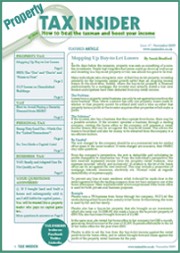Before you go, sign up to our free tax saving email course. Get 7 top property tax saving strategies in your email inbox that will help you save thousands in tax. Unsubscribe any time.
|
Negligible Value Claim The relief, known as a negligible value claim, is available for assets that have been or have become of negligible value. For these purposes, an asset is regarded as being of negligible value if it is worth next to nothing. Essentially, relief is given by allowing a taxpayer to make a claim be treated as if he or she had disposed of the asset and immediately reacquired it at the time that claim is made for a value as specified in the claim. This will be its negligible value, generally nil or a very small amount. The effect of this is to allow the taxpayer to realise a capital loss in respect of the asset without actually having to dispose of it. To be eligible to make a claim, the taxpayer must still own the asset and the asset must have become of negligible value during the taxpayer’s period of ownership. The effective date of the disposal must be specified in the claim and can be in the tax year in which the claim was made, or in any of the two preceding tax year. Where the claim is made for the disposal to be in an earlier tax year, the taxpayer must both own the asset at that earlier time and the asset must be of negligible value at the time of the deemed disposal.
Making the Claim
The claim can be made either in the self-assessment tax return or on form CG34. Alternatively, a claim can be made by writing to HMRC. If a claim is to be made for an earlier tax year, this can also be done by amending the tax return for that year. Shares Where a loss arises as a result of a negligible value claim in respect of shares in a qualifying trading company, provided that certain conditions are met a claim can be made to set the loss against income. This will allow the loss to be relieved where there are insufficient gains to absorb it and can give relief earlier than might otherwise be possible. Example Polly subscribed £500 for shares in a small business in 2006. The business failed in November 2009 and the shares became worthless. Polly makes a negligible value claim in 2009/10 and the resulting loss of £500 can be set against either her chargeable gains in the normal way or against her income for 2009/10 or 2008/09. The relief against income is only available if certain conditions are met. These relate to the type of company, the type of shares and the period of time for which the company has been a trading company. This article is from Property Tax Insider, a leading monthly UK tax magazine. Click here to slash your taxes today and get the first issue of Tax Insider for free. |


 Tax Articles
Tax Articles
